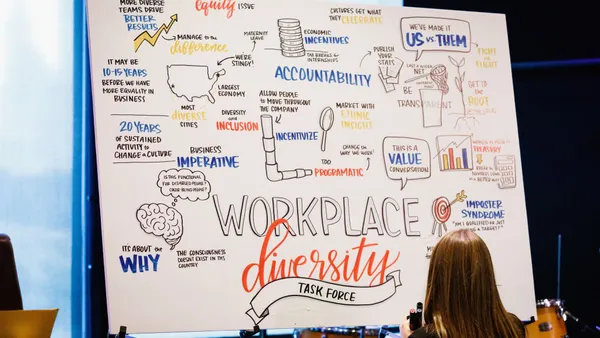Racism at work can take a number of forms, but it often flies under the radar, according to the CEO of a nonprofit focused on equity in the workplace.
In fact, most employees from marginalized racial and ethnic groups in six major countries said in a survey that they’ve experienced racism at work during their career, according to an Oct. 11 report from the organization, Catalyst. In addition, 52% of employees from these countries — Australia, Canada, New Zealand, South Africa, the U.K. and the U.S. — have experienced racism in their current job.
“Our findings show that racism in the workplace is deeply embedded, often flying under the radar in the form of offhand comments or other exclusionary behaviors,” Lorraine Hariton, president and CEO of Catalyst, said in a statement.
In the survey of more than 5,000 employees, the most common expressions of racism included workplace harassment (48%), such as racist jokes, slurs and other derogatory comments, as well as employment and professional inequities (32%), such as pay gaps, promotion discrepancies and more or less work than colleagues, based on race.
Survey participants also reported racial stereotypes and degrading commentary about their bodies or cultures. Stereotypes included assumptions about the worker’s intelligence, cleanliness or language abilities, as well as blame for COVID-19.
Overall, women and men experienced racism in the workplace to the same degree, but transgender and nonbinary employees experienced more racism than others.
Most often, the survey respondents named leaders (41%) as the people who perpetuated racism at work, though coworkers (36%) and customers/clients (23%) also contributed. In addition, women and men were equally as likely to instigate acts of racism; “notably, trans and nonbinary people were never listed as the instigators of racist acts,” according to the report.
Roughly 4 out of 5 reported acts of racism were initiated by White people, and 1 out of 5 were initiated by another non-White person.
To address these issues, HR may need to focus on training and getting executive buy-in, sources say. “It’s imperative that leaders at every level of an organization act to combat racism and build antiracist workplaces, address racist and discriminatory incidents and create environments of physical and psychological safety that enable employees to report racist experiences,” she said.
Additionally, HR pros may need to re-evaluate how candidates and employees are evaluated. Whiteness “is used as a lens through which employees, organizational policies, and business strategies are judged, assessed, and valued,” the report concluded. “When Whiteness is the default at work, people from marginalized racial and ethnic groups are pressured to conform to White standards of leadership, presentation and self-expression,” Joy Ohm, vice president, knowledge architect and writer at Catalyst, said in a statement.
“Our research shows that racism is a lever that leaders, colleagues and customers pull to apply this pressure and maintain the status quo,” she said.
Compared to other countries, U.S. workers have reported the highest rate of discrimination in the workplace, according to a recent report from Savanta. Racism and exclusion in the workplace can lead to turnover among marginalized racial and ethnic employees.
Additional surveys by the Society for Human Resource Management show significant gaps on racial equality in U.S. workplaces, including those who work in HR. Black and white workers expressed different beliefs and perceptions of racial discrimination, inequality and whether their employers were doing enough to provide opportunities for workers or promote racial justice.
As hiring practices continue to change, particularly with technology and AI tools, the U.S. Equal Employment Opportunity Commission has pledged to broaden its enforcement efforts to include systemic racism and AI-related bias. The commission has said it plans to address barriers in recruitment and hiring, protect vulnerable workers and those from underserved communities from employment discrimination and advance equal pay initiatives.











